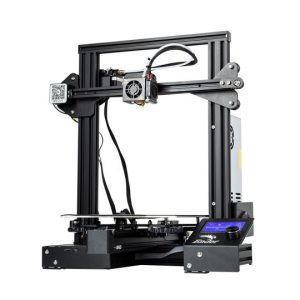Table of Contents:
Creality printers are unique devices. They include those from the Ender series, and it’s them that we’re going to cover in today’s article. They are primarily open source devices ideal for 3D printing rookies and professionals looking to create an affordable fleet of printers – or 3D printing farms, if you prefer – for the mass production of spatial objects of any purpose.
Let’s see how the architecture of the three solid pillars of FFF technology – here’s the Ender-3, Ender-3 Pro and Ender-3 V2.
Creality Ender 3 – not so ender, as everything begins here
Best cheap printer. For real. Not the freshest proposition, but still worthy of having. The Ender 3 is a phenomenon that spawned the next two models that will be talked today. The pre-assembled (to be precise: partially assembled) printer kit ranks right up there with the CR-10 when it comes to the 3D printer lineup from Creality – the CR series is a no-brainer, by the way. There’s no soldering, tinkering, or other advanced techniques that could put the Ender out of reach for beginners with limited tools or experience. A great place to start.
- Affordable price
- Easy installation and compact design
- Open source
- Tight filament path for improved compatibility
- Automatic print resume
- Slightly wobbling base, making it difficult to level
- Sometimes need grip to make prints adhere to the bed
- Requires manual calibration


For larger prints, you can opt for the Max version with bigger work bed. Both printers are supported by an aluminum frame for stability. Screw guide responsible for movement in Z axis, V profiles and pulleys provide smooth movement of the head, and improved cooling system consists of two hotend fans – with both sides of the air supply we do not have to worry about cooling of the filament.
More information and technical specifications of the printers can be found the product page at the store.
Creality Ender 3 Pro – don’t ask if it’s worth it, ask why it is
The Creality Ender-3 Pro model allows you to print with all the most popular materials, such as PLA, ABS, TPU, gradient filaments or carbon fiber filaments. Another advantage of the printer is the quick assembly and the fact that the workbench heats up to 110°C in 5 minutes.
- Advantages of Ender 3.
- Beginner-friendly assembly process.
- Easily modifiable frame.
- The 350W 24V power supply heats up quickly (thankfully, it doesn’t).
- Easy to use with solid print quality.
- Problems with head positioning have been reported – but this can be resolved.
- It is a bit noisy.
You can find the installation instructions in PDF file – no worries, we provide it. It’s also not hard to find some handy YouTube videos around. The most common problem with the Creality Ender-3 Pro is an uneven work bed. Moving the head to the center of the workbench does not necessarily put it in a perfectly centered position. Let’s mark the problem word – it’s an inconvenience, not a fatal design flaw beyond repair. Experienced users advise putting a sheet of glass or mirror on the printer, and using agents such as Dimafix spray or Dimafix pen in tube if you have trouble with adhesion after implementing such a solution.

Sold at a reasonable price of around €230, Creality Ender 3 Pro is one of the most popular FFF/FDM printers, that is operating on the most popular and affordable technology. It attracts both beginners and budget-minded creators, who are already a bit more familiar with 3D printing and become such budget-minded creators. It uses an open-source design, which makes it easy to modify. Great support and solid print quality make the Ender 3 Pro a truly affordable machine – and not the only one from the Creality stable worth trusting.
For more information and printer specifications visit the product page at the store.
Creality Ender 3 V2 – quieter, more stable and simply better
As guys from All3DP portal described it: Creality’s fan-favorite budget printer in its new iteration, the Ender 3 V2, doesn’t reinvent the wheel, but surely modernizes it. This model retains what was liked about the previous Ender 3 installment and improves on certain areas. It also offers easy installation, really pleasant user experience and high printouts quality for this class of device.
3D printer sounds can be very annoying. The below-50-decibels noise reduction of the Ender-3 V2 is achieved thanks to an upgraded motherboard. An ultra-quiet TMC2208 controllers have been developed in-house, are industrial-grade despite the fact that we are talking about a commercial and budget printer, and in short: they are simply value for money because we are not paying anything extra here for the best features available.
We also get UI with a 4.3-inch color screen packed with a new layout, a carborundum glass workbed overlay, a brass nozzle that can handle high temperatures and a knob for filament feed/removal. No more uneven work surfaces like its predecessor. Ender V2 uses Bowden extruder instead of Direct-Drive one – well, whatever you like, because it can’t be a disadvantage.
- Advantages of previous versions.
- Ultra-silent operation with new motherboard drivers.
- Easy to assemble and maintain.
- Print resume function.
- Glass overlay for easier peeling of printouts.
- Stable and durable all-metal body.
- Integrated power supply under the construction plate.
- No touch screen or BL-Touch.

The Creality Ender-3 V2 3D printer is getting some really happy feedback from its users. Producent has significantly improved its latest model over the previous generation. A number of improvements have been made to an already great working device, making it easier and faster to get the job done. And yes, you can start with Ender 3 version V2 – the new model with the number two doesn’t mean you have to have more advanced skills or tools.
All three of Great Enders and more 3D printers await you on the Botland store.


How useful was this post?
Click on a star to rate it!
Average rating 0 / 5. Vote count: 0
No votes so far! Be the first to rate this post.




















